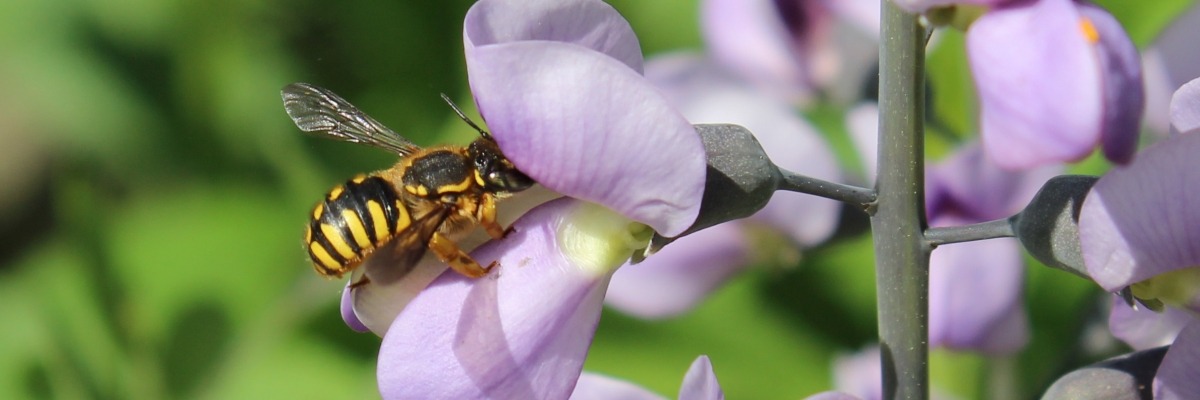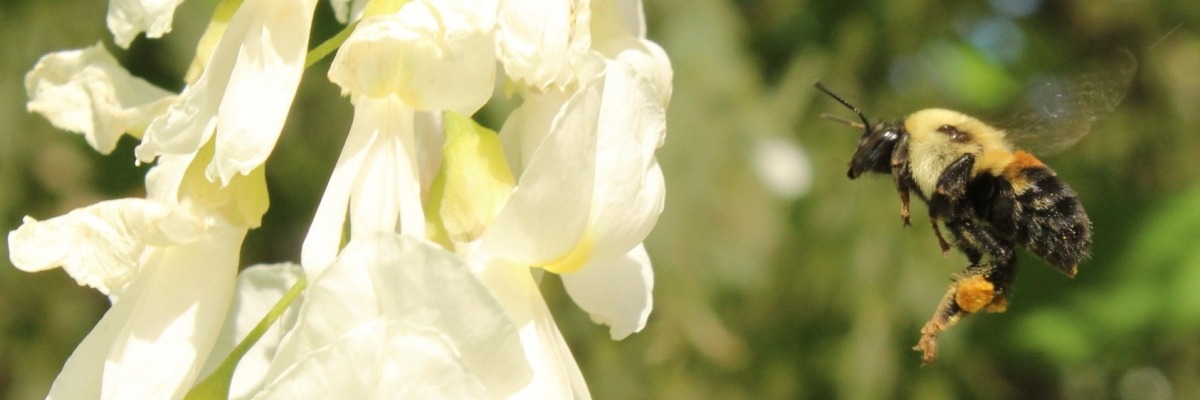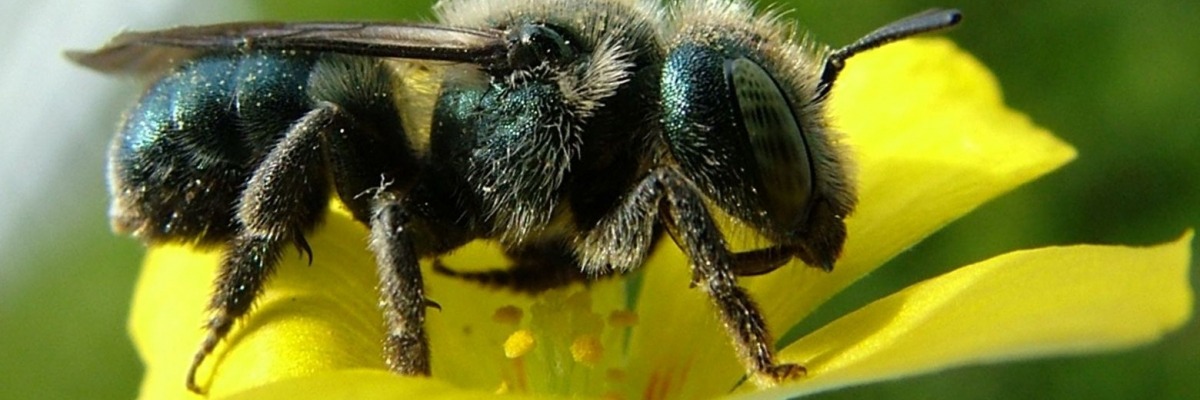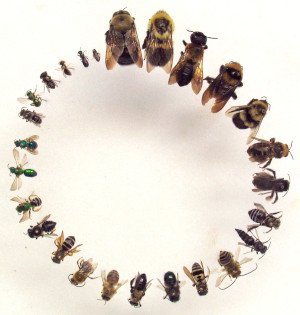
Bees come in many sizes and colors
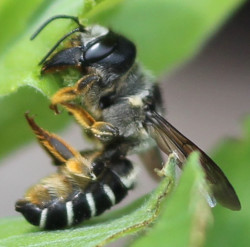
Sunflower leafcutter bee (Megachile pugnata) cutting a leaf to separate brood cells in her nest
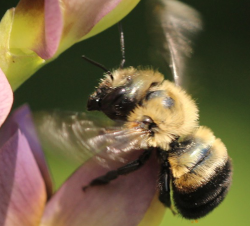
Bufflehead mason bee (Osmia bucephala) taking off from Baptisia flower
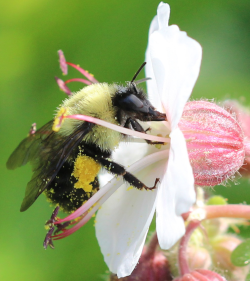
Two spotted bumble bee (Bombus bimaculatus) on geranium flower
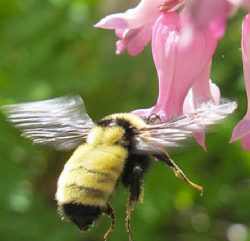
Yellow bumble bee (Bombus fervidus) on bleeding hearts flower. Photo by Rosemary Malfi
Learn About Some of Our Bees
Click a photo below to learn about each.
Squash Bee
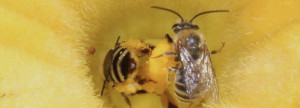
Squash bees (Eucera pruinosa) like squash. The females collect pollen only from squash, pumpkins and gourds. The males spend the day looking for females in flowers and then crawl into the flowers as they close near midday to spend the night. Females nest in the ground, often right under the squash plants. They are excellent pollinators of squash in backyard gardens and often the predominant pollinator of squash and pumpkin in agriculture, but are not managed for pollination --they just show up on their own. A good motto for squash bees: "Will Work for Food." Learn more.
Rusty Patched Bumble Bee (Photo: Rich Hatfield, Xerces Society)

The rusty patched bumble bee (Bombus affinis) used to be one of the most common bumble bee species in eastern North America. It underwent a precipitous decline from the 1980s through today and became the first bee species in the continental U.S. to be put on the endangered species list. The main cause of its decline is uncertain, but the clearest source evidence is infection by a fungal disease, Nosema bombi, which spread quickly across bumble bee populations from the 1980s to today and is associated with preciipitous declines in several other bumble bee species. The photo below is of a bee found in Sky Meadows State Park, Fauquier County, Virginia in 2014 and was the first capture of the species in Virginia since the 1990s. Extensive searching has located populations in the mountainous border of Virginia and West Virginia. Currently, the species is only found in the upper midwest (mainly Wisconsin, Minnesota and Iowa) as well as this mountainous band of Virginia and West Virginia. It has disappeared from its former range in the northeatern U.S. and adjacent Canada.
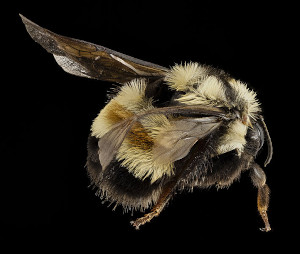
Sunflower Leafcutter Bee

Sunflower leafcutter bees (Megachile pugnata) collect pollen from sunflowers and other plants in the composite family, including thistle, to feed their offspring. They nest above ground in linear cavities and separate each offspring with a leaf partition. In our area they often use evening primrose and smartweed leaves. Below, a bee caps her finished nest with leaf pieces and pebbles while another cuts a leaf to bring back to her nest.
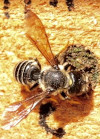
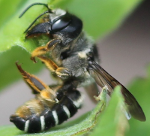
Bufflehead Mason Bee (larva on pollen)

The bufflehead mason bee (Osmia bucephala) is a cavity nesting bee active April-June. After the larva eats all the food its mother provides, it turns into an adult by late summer. It will stay in the nest until the following spring then emerge to forage on its favorite host plants and start its own nest. It collects leaf material to create separate chambers for each of its offspring. Watch this video to see how it collects leaf material.
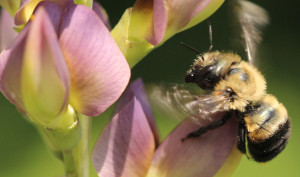
Osmia bucephala on Baptisia
Groundcherry Bee
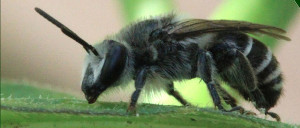
The groundcherry bee (Colletes latitarsis) is a specialist of groundcherries. Females collect pollen only from groundcherries and the males search the flowers looking for females. Bees in the genus Colletes are called polyester bees because they line their nests in the ground with a thin water-repellent secretion similar in feel to plastic.
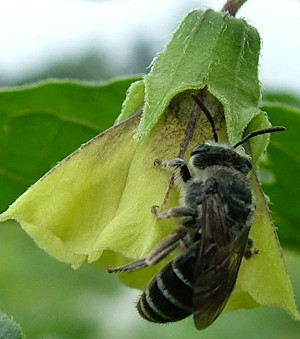
Black and Gold Bumble Bee
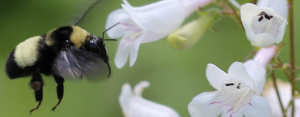
The black and gold bumble bee is the largest of the bumble bees in the Mid Atlantic United States. It is a 'long tongued' bumble bee that relies on flowers with long floral tubes, like penstemon and bee balm, for its nectar supply.
Cuckoo Bees

Cuckoo bees lay their eggs in the nests of other bees. A female sneaks into the nest of a solitary bee when she is out foraging and lays an egg in an open brood cell. When the egg hatches into a larva it kills the host larva and eats its food.
Invasive Bees

Some bee species get transported to new areas either intentionally for agriculture or accidentally in shipping containers and then thrive in the new area, potentially at the expense of native bees.
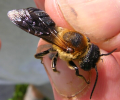
The Asian giant resin bee (Megachile sculpturalis) pictured above is widespread in the eastern United States. It often nests in carpenter bee burrows and will use plant resin not only to line its nests but also as a weapon, covering carpenter bees with it until they cannot fly and dragging them out of their nests and leaving them on the ground, where they will likely die. Pictured below is a carpenter bee covered in resin.
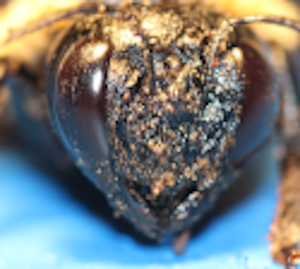
The European wool carder bee (Anthidium manicatum) shown below is now widespread in the United States.
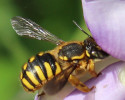
Females are commonly seen scraping the hairs off lambs ear (Stachys byzantina) leaves. They use the hairs to help construct their nest, either in a cavity or a partially sheltered overhang. The males (see below) patrol aerial territories that contain flower patches favored by the females (often mint family plants). The males are extremely aggressive toward other insects, colliding with them in flight or dragging them out of flowers. They even attack bumble bees, which are much larger than they are. By eliminating competition from other insects for the floral nectar, female wool carder bees repeatedly return to the patch where nectar is plentiful and the males then try to mate with them.

The mason bee Osmia taurus was first recorded in the U.S. in 2002 in West Virginia and Maryland and is spreading rapidly through the eastern states. It is 
now the most commonly collected mason bee species in the mid Atlantic region, even though there are over 20 native mason bee species in the area. Recent work shows that while this species has spread at an extraordinary rate, many native bee species are declining rapidly.
Life Cycle of a Leafcutter Bee

The alfalfa leafcutter bee, Megachile rotundata, is managed for pollination of alfalfa. Upon emergence in early summer, it searches for a cavity to start its nest.,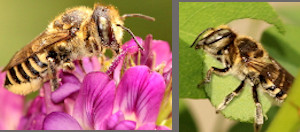 Once it has a nest, it collects pollen and nectar to feed its offspring and pieces of leaves to separate its offspring in separate chambers.
Once it has a nest, it collects pollen and nectar to feed its offspring and pieces of leaves to separate its offspring in separate chambers.

The finished nest is a long row of leaf capsules. Inside the leaf capsules is a single offspiring eating its food and progressing from egg to larva, pupa and adult while eating the food its mother provided but never seeing her. They overwinter in a late larval stage (middle photo below) and emerge as an adult the next year or, in some cases, later the same year.

The Bees of Blandy
Agapostemon sericeus
Agapostemon splendens
Agapostemon texanus
Agapostemon virescens
Andrena carlini
Andrena ceanothi
Andrena commoda
Andrena crataegi
Andrena cressonii
Andrena erigeniae
Andrena forbesii
Andrena hippotes
Andrena imitatrix
Andrena macra
Andrena miserabilis
Andrena nasonii
Andrena nuda
Andrena perplexa
Andrena rudbeckiae
Andrena salictaria
Andrena viburnella
Andrena vicina
Andrena violae
Andrena wilkella
Anthidiellum notatum
Anthidium manicatum
Anthidium oblongatum
Anthophora abrupta
Anthophora bomboides
Anthophora terminalis
Apis mellifera
Augochlora pura
Augochlorella aurata
Augochlorella persimilis
Augochloropsis metallica
Augochloropsis metallica
Bombus affinis
Bombus auricomus
Bombus bimaculatus
Bombus citrinus
Bombus fervidus
Bombus griseocollis
Bombus impatiens
Bombus pensylvanicus
Bombus perplexus
Bombus vagans
Calliopsis andreniformis
Cemolobus ipomoeae
Ceratina calcarata
Ceratina dupla
Ceratina strenua
Chelostoma philadelphi
Coelioxys alternata
Coelioxys moesta
Coelioxys rufitarsis
Coelioxys sayi
Colletes compactus
Colletes latitarsis
Epeolus bifasciatus
Eucera atriventris
Eucera hamata
Eucera pruinosa
Habropoda laboriosa
Halictus confusus
Halictus ligatus
Halictus parallelus
Halictus rubicundus
Heriades carinatus
Heriades leavitti
Heriades variolosus
Holcopasites calliopsidis
Hoplitis pilosifrons
Hoplitis producta
Hylaeus affinis
Hylaeus mesillae
Hylaeus modestus
Lasioglossum achillae
Lasioglossum admirandum
Lasioglossum albipenne
Lasioglossum asteris
Lasioglossum birkmanni
Lasioglossum bruneri
Lasioglossum cinctipes
Lasioglossum coreopsis
Lasioglossum coriaceum
Lasioglossum forbesii
Lasioglossum fuscipenne
Lasioglossum heterognathum
Lasioglossum illinoense
Lasioglossum imitatum
Lasioglossum laevissimum
Lasioglossum leucozonium
Lasioglossum nymphaearum
Lasioglossum oblongum
Lasioglossum pectinatum
Lasioglossum perpunctatum
Lasioglossum pilosum
Lasioglossum platyparium
Lasioglossum pruinosum
Lasioglossum quebecense
Lasioglossum rohweri
Lasioglossum tegulare
Lasioglossum truncatum
Lasioglossum versans
Lasioglossum versatum
Lasioglossum zephyrum
Megachile brevis
Megachile campanulae
Megachile campanulae
Megachile exilis
Megachile inimica
Megachile latimanus
Megachile mendica
Megachile montivaga
Megachile petulans
Megachile pugnata
Megachile rotundata
Megachile rugifrons
Megachile sculpturalis
Megachile xylocopoides
Melissodes agilis
Melissodes bimaculata
Melissodes denticulata
Melissodes desponsa
Melissodes subillata
Melissodes trinodis
Melitoma taurea
Nomada armatella
Nomada articulata
Nomada composita
Nomada denticulata
Nomada imbricata
Nomada pygmaea
Osmia [leaf user]
Osmia albiventris
Osmia bucephala
Osmia collinsiae
Osmia conjuncta
Osmia cornifrons
Osmia georgica
Osmia lignaria
Osmia pumila
Osmia subfasciata
Osmia taurus
Osmia texana
Paranthidium jugatorium
Ptilothrix bombiformis
Sphecodes heraclei
Sphecodes illinoensis
Sphecodes pimpinellae
Sphecodes stygius
Stelis louisae
Svastra aegis
Svastra obliqua
Svastra obliqua
Svastra obliqua
Triepeolus lunatus
Triepeolus remigatus
Triepeolus simplex
Xylocopa virginica
Key To Metallic Green Halictidae of Blandy (Gretchen Allen)
All photos, unless otherwise noted, by T'ai Roulston.
Questions about this page should be directed to T'ai Roulston tai.roulston@virginia.edu




